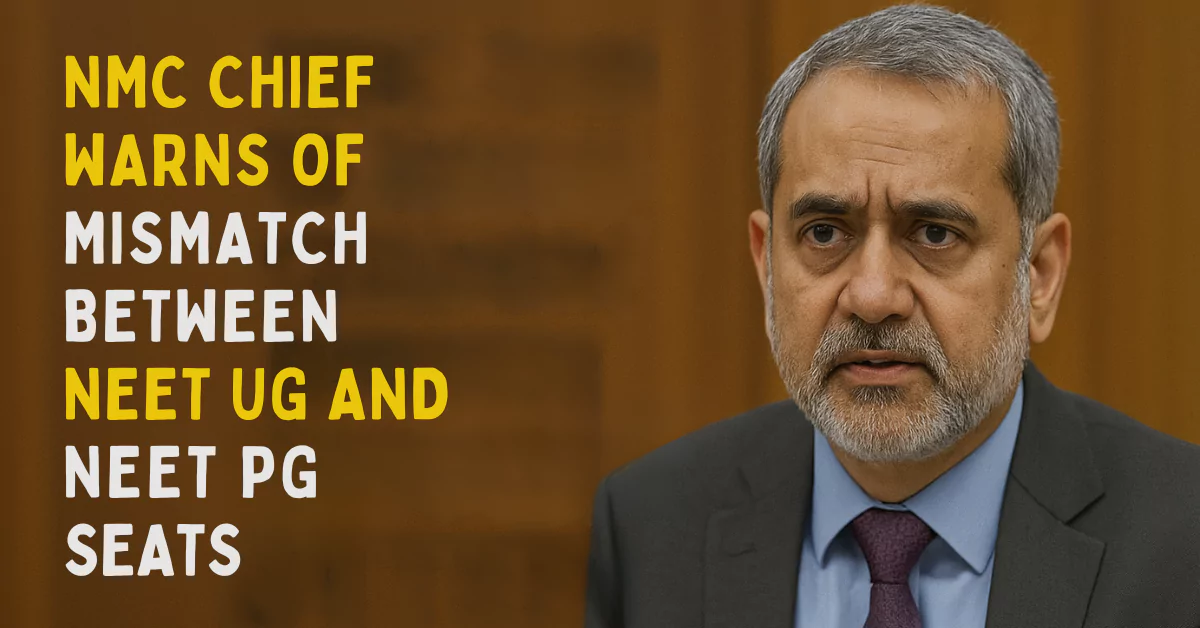The National Medical Commission (NMC) Chairperson, Dr. B.N. Gangadhar, warns of ongoing issues of mismatch between NEET UG and NEET PG seats in Indian medical education. Addressing this at a policy dialogue organised by the Centre for Social and Economic Progress (CSEP), he called the challenge “recurring,” pointing out how it affects both education quality and student well-being.
NMC Chief Statemen: Key Highlights
- Mismatch in Seat Numbers: India currently has over 1,18,000 MBBS seats but lacks sufficient PG seats to match the inflow of medical graduates. This imbalance leads to significant backlog and stress among residents.
- Overburdened System, Limited Faculty: According to Dr. Gangadhar, PG training programs continue with old faculty counts even as patient loads increase, resulting in overworked residents and compromised patient care.
- Faculty Shortages Hamper Expansion: Many government medical colleges, despite having thousands of beds, have not been able to expand PG seats due to faculty shortages and infrastructure bottlenecks.
- Strategic Utilisation of Resources Proposed: Dr. Gangadhar advocated for better use of existing beds and clinical services to improve PG training capacity. According to him, such optimisation would help alleviate workloads and offer faculty relief.
- Quality Over Quantity: Dr. Gangadhar underscored that medical education must focus on educational outcomes, not just seat count. He suggested tools like a national exit exam and investing in faculty quality and modern infrastructure.
NEET UG and NEET PG Seats: Trends and Data
- This year alone, 95 institutes (60 private, 30 government) have applied to NMC to expand MBBS/PG seats, with around 120 private and 40 government colleges seeking to increase UG seats.
- Despite hospitals with up to 7,000 beds, many government colleges remain capped at 250 MBBS seats, signalling a mismatch in infrastructure use.
- India sees around 2.5 million applications vying for 1,18,000 MBBS seats, yet PG seat expansion lags far behind.
1. Increase in Seat Numbers
- MBBS (UG) seats:
- From ~51,348 in 2014 to ~118,190 in 2025 (↑130%)
- PG medical seats:
- From ~31,185 in 2014 to ~74,306 in 2025 (↑138%)
2. Vacant Seats
- UG seats:
- 2020‑21: 273 vacant (0.3%)
- 2021‑22: 326
- 2022‑23: 261
- PG seats:
- 2020‑21: 4,614 vacant (8.3%)
- 2021‑22: 3,744 (6.2%)
- 2022‑23: 4,400 (6.8%)
- Note: 485 UG + 247 PG seats left vacant (despite zero-percentile-based eligibility)
3. Demand vs Supply Gap
- Applicant-seats ratio:
- NEET‑UG: ~20 lakh applicants vs ~1.08 lakh seats (~1 in 5 success)
- NEET‑PG: ~2.28 lakh candidates vs ~74k seats
- Growth in aspirants:
- MBBS applicants surged 166% (2014–2021), but seats rose only 58%
- Result: rise in MBBS seekers studying abroad and FMGE exams (~479% increase in FMGE takers since 2009)
4. Government Response
- Goal: Achieve 1:1 UG:PG seat ratio, with PG seats rising from ~17,000 to 25,000 by 2030
- Plan: Use DNB and diploma seats, especially in underserved specialities
5. Unequal Filling Across Specialities
- High vacancies remain especially in:
- Non-clinical PG branches: anatomy (33 vacancies), pharmacology (144), microbiology (181), biochemistry (81)
- Even clinical majors like general medicine (1,743), surgery (723) faced significant unfilled seats
| Category | 2014 Seats | 2025 Seats | % Growth |
| MBBS (UG) | ~51,348 | ~118,190 | 130% |
| PG Medical | ~31,185 | ~74,306 | 138% |
- UG seat vacancies range: ~0.2–0.4%
- PG vacancies hover around 6–8%
Implications of the UG and PG Seats Mismatch
- Mental Health Risks: The scarcity of PG seats is contributing to early trainee burnout and heightened stress.
- Quality vs. Scale Dilemma: The fast-tracked expansion of medical institutions must be balanced with systematic faculty recruitment and infrastructure adaptation.
- Regulatory Calls: The government’s recent loosening of approval norms has encouraged growth, but also raised concerns about regional imbalances and compromised educational quality.
Key Recommendation
- Public–Private Cooperation: Dr. Gangadhar emphasised coordinated action to ensure balanced scale and standards in medical education.
- Optimising Existing Infrastructure: He urged colleges to fully utilise existing hospital beds for PG training.
- Policy-Level Tools: He suggested mechanisms like exit exams to monitor training quality and strengthen faculty commitments.
- Cautious Expansion: He cautioned against indiscriminate expansion, urging that seat additions be demand-driven and quality-focused.
The key address by Dr. Gangadhar underscores a larger systemic imbalance: India’s medical education system is producing many doctors but is failing to equip them adequately with postgraduate training seats. Bridging this UG-PG gap requires thoughtful policymaking, integrated growth strategies, faculty-focused reforms, and stringent quality access. The challenge, he warns, is not just expansion, but scaling responsibly without compromising standards.
Read Also: NEET UG 2025 Alert: Govt Announces Addition of 10,000 New MBBS Seats
| NEET UG Counselling Guide 2025 | |
|---|---|
| State-wise MBBS/BDS Counselling Guide eBook 2025 | 📥 Download |
| MCC NEET UG Counselling Guide eBook 2025 | 📥 Download |
| AACCC AYUSH NEET Counselling Guide eBook 2025 | 📥 Download |

